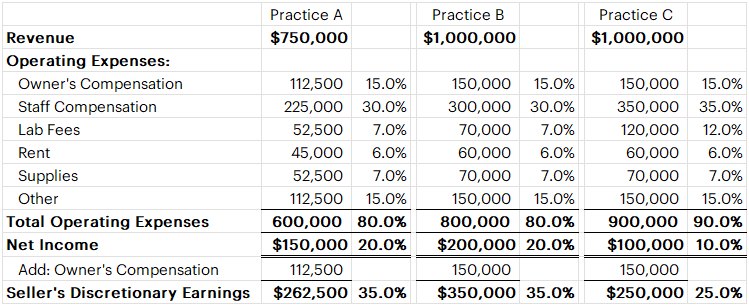15 Nov The Pitfalls of Price to Revenue Multiples
Written by: Ben Varone, CVA
(2 – 4 minute read)
A price to revenue multiple represents the ratio between the value of a business and its annual revenues. This multiple (also referred to as a revenue multiple or sales multiple) is often used by business owners, brokers, and other professionals to estimate the value of a business due to its simplicity. However, relying solely on a revenue multiple results in a value that might not be supported by the cash flow of the business, which is considered the primary driver of the value of any business. While certain industries with typically consistent expense structures (namely accounting firms, dental practices, investment firms, and insurance agencies) have widely agreed upon standard revenue multiples, these are only applicable when the subject company’s expense structure is in line with industry standards.
For example, the table below depicts the performance of three general dentistry practices:

Practice A is smaller than Practice B, but both operate with expense structures similar to industry averages. Meanwhile, Practice C has the same level of revenues as Practice B but is not operated as efficiently due to higher staff wages and lab fees.
In the table below, standard multiples for dentistry practices (roughly 2.0 times SDE and 0.7 times revenues) are applied to the example practices:

Practice A and Practice B show equal values derived from the sales multiple and earnings multiple because the earnings margins match up to the industry standard. Meanwhile, Practice C shows a large difference between the sales and earnings multiple values due to its inefficient expense structure. Similarly, there would be an inverse relationship between the two values if Practice C instead operated at stronger margins than the industry averages. Despite Practice B earning $100,000 more per year than Practice C, the sales multiples result in the same values. Cash flow is the most important consideration for a business owner, and all else considered equal, a higher cash flow should result in a higher value as it is worth more to a hypothetical buyer.
While revenue multiples can be quick and simple to apply, caution should be used when relying upon them for estimates of value as they can lead to faulty expectations as they do not consider the expense structure and earnings of a business.

